ABS KIA Rondo 2016 3.G User Guide
[x] Cancel search | Manufacturer: KIA, Model Year: 2016, Model line: Rondo, Model: KIA Rondo 2016 3.GPages: 586, PDF Size: 22.03 MB
Page 437 of 586
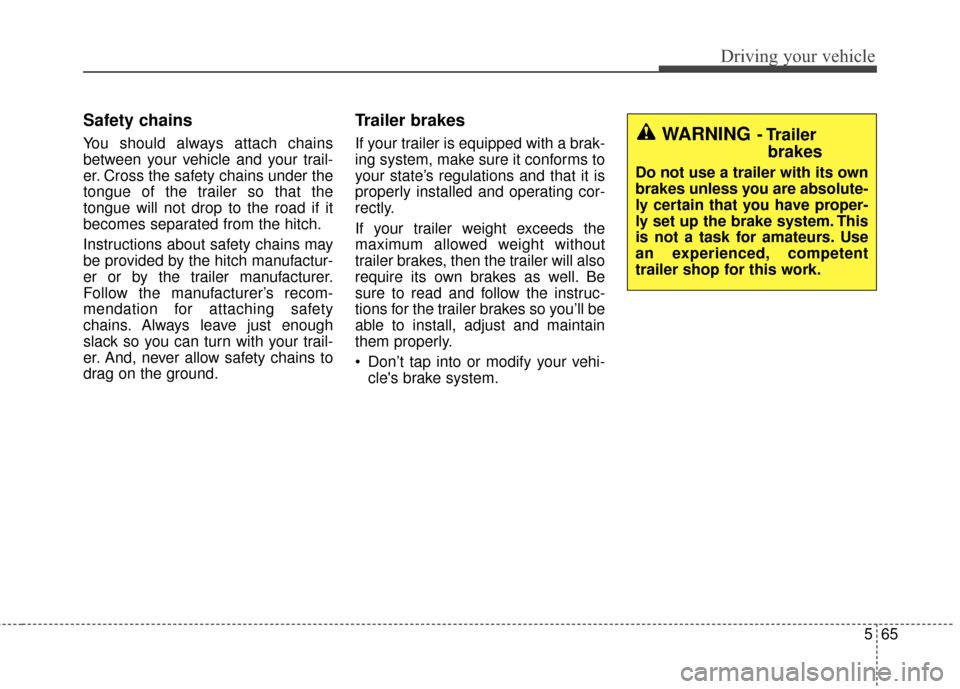
565
Driving your vehicle
Safety chains
You should always attach chains
between your vehicle and your trail-
er. Cross the safety chains under the
tongue of the trailer so that the
tongue will not drop to the road if it
becomes separated from the hitch.
Instructions about safety chains may
be provided by the hitch manufactur-
er or by the trailer manufacturer.
Follow the manufacturer’s recom-
mendation for attaching safety
chains. Always leave just enough
slack so you can turn with your trail-
er. And, never allow safety chains to
drag on the ground.
Trailer brakes
If your trailer is equipped with a brak-
ing system, make sure it conforms to
your state’s regulations and that it is
properly installed and operating cor-
rectly.
If your trailer weight exceeds the
maximum allowed weight without
trailer brakes, then the trailer will also
require its own brakes as well. Be
sure to read and follow the instruc-
tions for the trailer brakes so you’ll be
able to install, adjust and maintain
them properly.
Don’t tap into or modify your vehi-cle's brake system.WARNING- Trailerbrakes
Do not use a trailer with its own
brakes unless you are absolute-
ly certain that you have proper-
ly set up the brake system. This
is not a task for amateurs. Use
an experienced, competent
trailer shop for this work.
Page 440 of 586
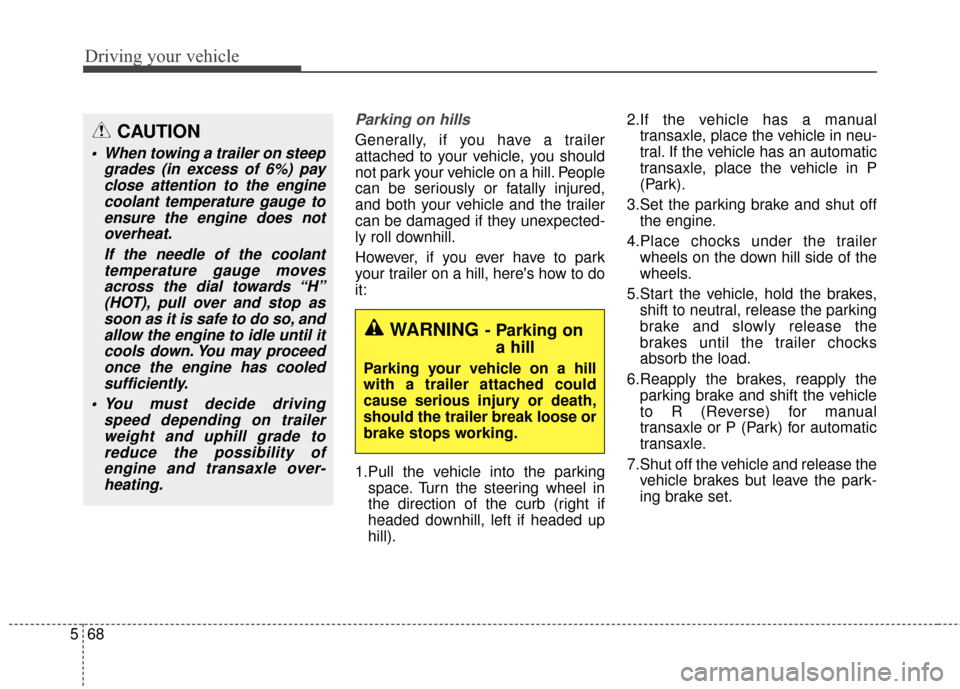
Driving your vehicle
68
5
Parking on hills
Generally, if you have a trailer
attached to your vehicle, you should
not park your vehicle on a hill. People
can be seriously or fatally injured,
and both your vehicle and the trailer
can be damaged if they unexpected-
ly roll downhill.
However, if you ever have to park
your trailer on a hill, here's how to do
it:
1.Pull the vehicle into the parking
space. Turn the steering wheel in
the direction of the curb (right if
headed downhill, left if headed up
hill). 2.If the vehicle has a manual
transaxle, place the vehicle in neu-
tral. If the vehicle has an automatic
transaxle, place the vehicle in P
(Park).
3.Set the parking brake and shut off the engine.
4.Place chocks under the trailer wheels on the down hill side of the
wheels.
5.Start the vehicle, hold the brakes, shift to neutral, release the parking
brake and slowly release the
brakes until the trailer chocks
absorb the load.
6.Reapply the brakes, reapply the parking brake and shift the vehicle
to R (Reverse) for manual
transaxle or P (Park) for automatic
transaxle.
7.Shut off the vehicle and release the vehicle brakes but leave the park-
ing brake set.CAUTION
When towing a trailer on steep grades (in excess of 6%) payclose attention to the enginecoolant temperature gauge toensure the engine does notoverheat.
If the needle of the coolanttemperature gauge movesacross the dial towards “H”(HOT), pull over and stop assoon as it is safe to do so, andallow the engine to idle until itcools down. You may proceedonce the engine has cooledsufficiently.
You must decide driving speed depending on trailerweight and uphill grade toreduce the possibility ofengine and transaxle over-heating.
WARNING- Parking on a hill
Parking your vehicle on a hill
with a trailer attached could
cause serious injury or death,
should the trailer break loose or
brake stops working.
Page 470 of 586
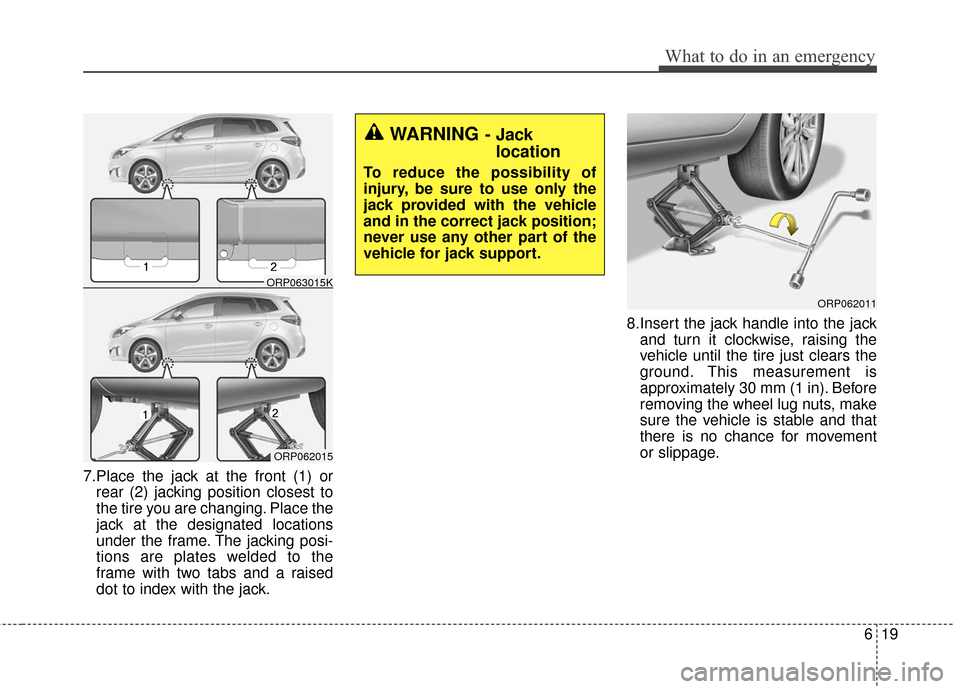
619
What to do in an emergency
7.Place the jack at the front (1) orrear (2) jacking position closest to
the tire you are changing. Place the
jack at the designated locations
under the frame. The jacking posi-
tions are plates welded to the
frame with two tabs and a raised
dot to index with the jack. 8.Insert the jack handle into the jack
and turn it clockwise, raising the
vehicle until the tire just clears the
ground. This measurement is
approximately 30 mm (1 in). Before
removing the wheel lug nuts, make
sure the vehicle is stable and that
there is no chance for movement
or slippage.
ORP062011
WARNING- Jack location
To reduce the possibility of
injury, be sure to use only the
jack provided with the vehicle
and in the correct jack position;
never use any other part of the
vehicle for jack support.
ORP062015
ORP063015K
Page 531 of 586
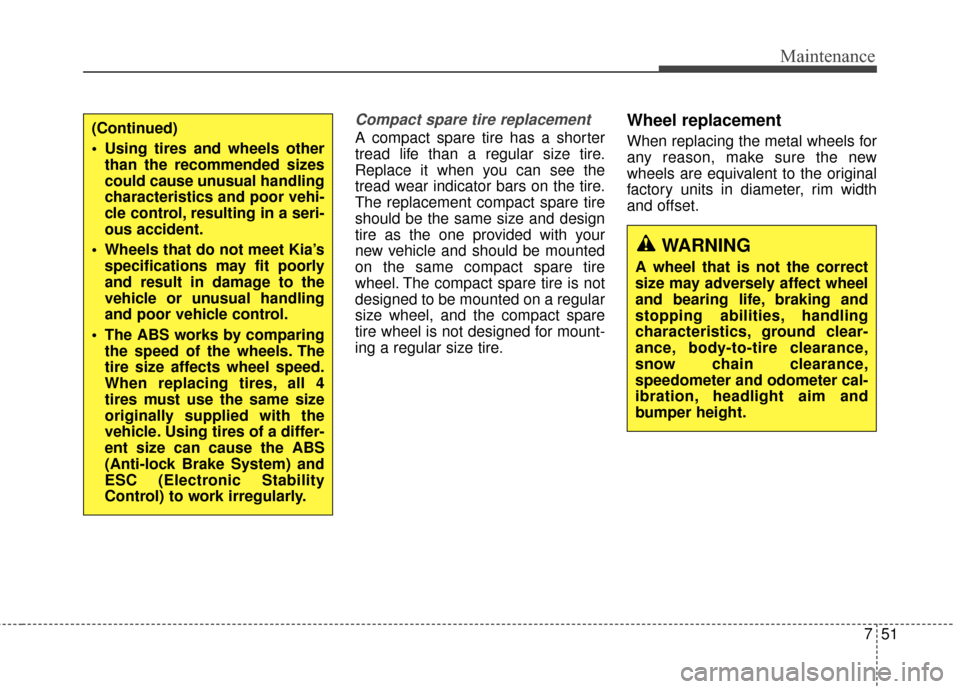
751
Maintenance
Compact spare tire replacement
A compact spare tire has a shorter
tread life than a regular size tire.
Replace it when you can see the
tread wear indicator bars on the tire.
The replacement compact spare tire
should be the same size and design
tire as the one provided with your
new vehicle and should be mounted
on the same compact spare tire
wheel. The compact spare tire is not
designed to be mounted on a regular
size wheel, and the compact spare
tire wheel is not designed for mount-
ing a regular size tire.
Wheel replacement
When replacing the metal wheels for
any reason, make sure the new
wheels are equivalent to the original
factory units in diameter, rim width
and offset.(Continued)
Using tires and wheels otherthan the recommended sizes
could cause unusual handling
characteristics and poor vehi-
cle control, resulting in a seri-
ous accident.
Wheels that do not meet Kia’s specifications may fit poorly
and result in damage to the
vehicle or unusual handling
and poor vehicle control.
The ABS works by comparing the speed of the wheels. The
tire size affects wheel speed.
When replacing tires, all 4
tires must use the same size
originally supplied with the
vehicle. Using tires of a differ-
ent size can cause the ABS
(Anti-lock Brake System) and
ESC (Electronic Stability
Control) to work irregularly.
WARNING
A wheel that is not the correct
size may adversely affect wheel
and bearing life, braking and
stopping abilities, handling
characteristics, ground clear-
ance, body-to-tire clearance,
snow chain clearance,
speedometer and odometer cal-
ibration, headlight aim and
bumper height.
Page 552 of 586

Maintenance
72
7
No.Fuse ratingDescriptionProtected component
317.5AMODULE 4Body Control Module
327.5AMODULE 7Body Control Module, Smart Key Control Module
3315ATCUM/T : F35 (B/UP LAMP), A/T : Transaxle Range Switch, TCM (D4HB)
3410AABSESC Control Module, ABS Control Module
357.5AA/CON 2A/C Control Module
3615AS/HEATER RRRear Seat Warmer LH/RH
3725AAMPAMP, DC-DC Converter (With ISG)
3810AFOG LAMP RRICM Relay Box (Rear Fog Lamp Relay)
Page 553 of 586
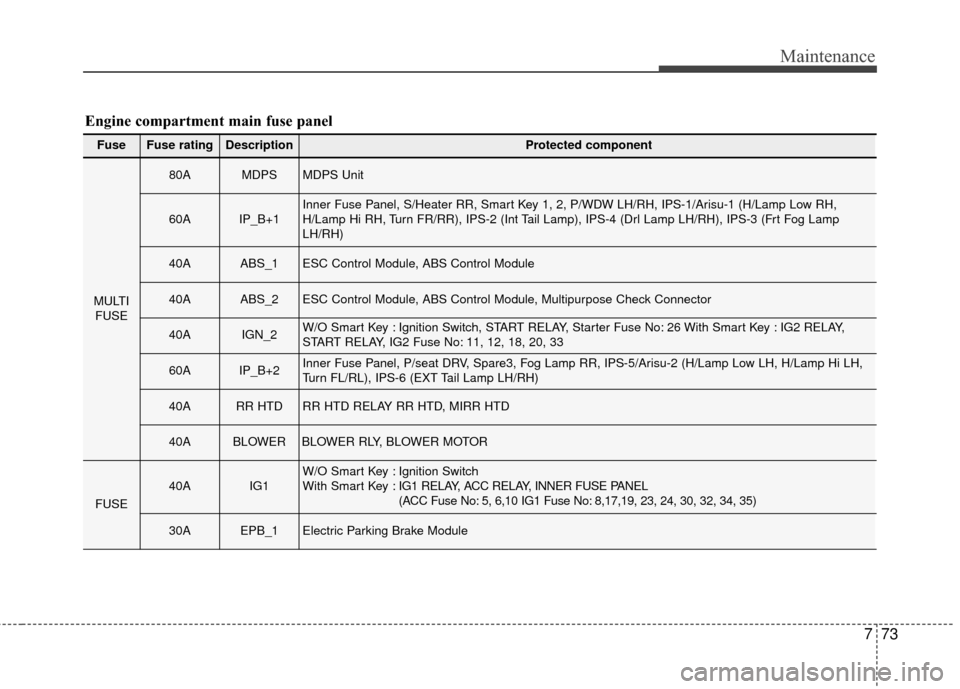
773
Maintenance
Fuse Fuse ratingDescriptionProtected component
MULTIFUSE
80AMDPSMDPS Unit
60AIP_B+1Inner Fuse Panel, S/Heater RR, Smart Key 1, 2, P/WDW LH/RH, IPS-1/Arisu-1 (H/Lamp Low RH,
H/Lamp Hi RH, Turn FR/RR), IPS-2 (Int Tail Lamp), IPS-4 (Drl Lamp LH/RH), IPS-3 (Frt Fog Lamp
LH/RH)
40AABS_1ESC Control Module, ABS Control Module
40AABS_2ESC Control Module, ABS Control Module, Multipurpose Check Connector
40AIGN_2W/O Smart Key : Ignition Switch, START RELAY, Starter Fuse No: 26 With Smart Key : IG2 RELAY,
START RELAY, IG2 Fuse No: 11, 12, 18, 20, 33
60AIP_B+2Inner Fuse Panel, P/seat DRV, Spare3, Fog Lamp RR, IPS-5/Arisu-2 (H/Lamp Low LH, H/Lamp Hi LH,
Turn FL/RL), IPS-6 (EXT Tail Lamp LH/RH)
40ARR HTDRR HTD RELAY RR HTD, MIRR HTD
40ABLOWERBLOWER RLY, BLOWER MOTOR
FUSE
40AIG1W/O Smart Key : Ignition Switch
With Smart Key : IG1 RELAY, ACC RELAY, INNER FUSE PANEL
(ACC Fuse No: 5, 6,10 IG1 Fuse No: 8,17,19, 23, 24, 30, 32, 34, 35)
30AEPB_1Electric Parking Brake Module
Engine compartment main fuse panel
Page 564 of 586
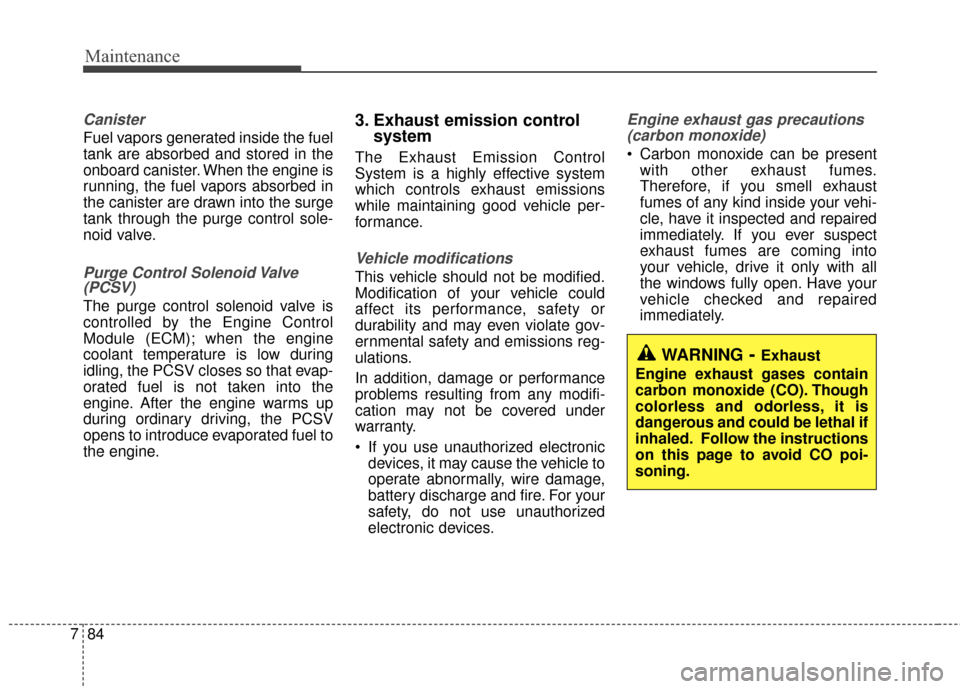
Maintenance
84
7
Canister
Fuel vapors generated inside the fuel
tank are absorbed and stored in the
onboard canister. When the engine is
running, the fuel vapors absorbed in
the canister are drawn into the surge
tank through the purge control sole-
noid valve.
Purge Control Solenoid Valve
(PCSV)
The purge control solenoid valve is
controlled by the Engine Control
Module (ECM); when the engine
coolant temperature is low during
idling, the PCSV closes so that evap-
orated fuel is not taken into the
engine. After the engine warms up
during ordinary driving, the PCSV
opens to introduce evaporated fuel to
the engine.
3. Exhaust emission control system
The Exhaust Emission Control
System is a highly effective system
which controls exhaust emissions
while maintaining good vehicle per-
formance.
Vehicle modifications
This vehicle should not be modified.
Modification of your vehicle could
affect its performance, safety or
durability and may even violate gov-
ernmental safety and emissions reg-
ulations.
In addition, damage or performance
problems resulting from any modifi-
cation may not be covered under
warranty.
If you use unauthorized electronic
devices, it may cause the vehicle to
operate abnormally, wire damage,
battery discharge and fire. For your
safety, do not use unauthorized
electronic devices.
Engine exhaust gas precautions(carbon monoxide)
Carbon monoxide can be present with other exhaust fumes.
Therefore, if you smell exhaust
fumes of any kind inside your vehi-
cle, have it inspected and repaired
immediately. If you ever suspect
exhaust fumes are coming into
your vehicle, drive it only with all
the windows fully open. Have your
vehicle checked and repaired
immediately.
WARNING- Exhaust
Engine exhaust gases contain
carbon monoxide (CO). Though
colorless and odorless, it is
dangerous and could be lethal if
inhaled. Follow the instructions
on this page to avoid CO poi-
soning.
Page 577 of 586
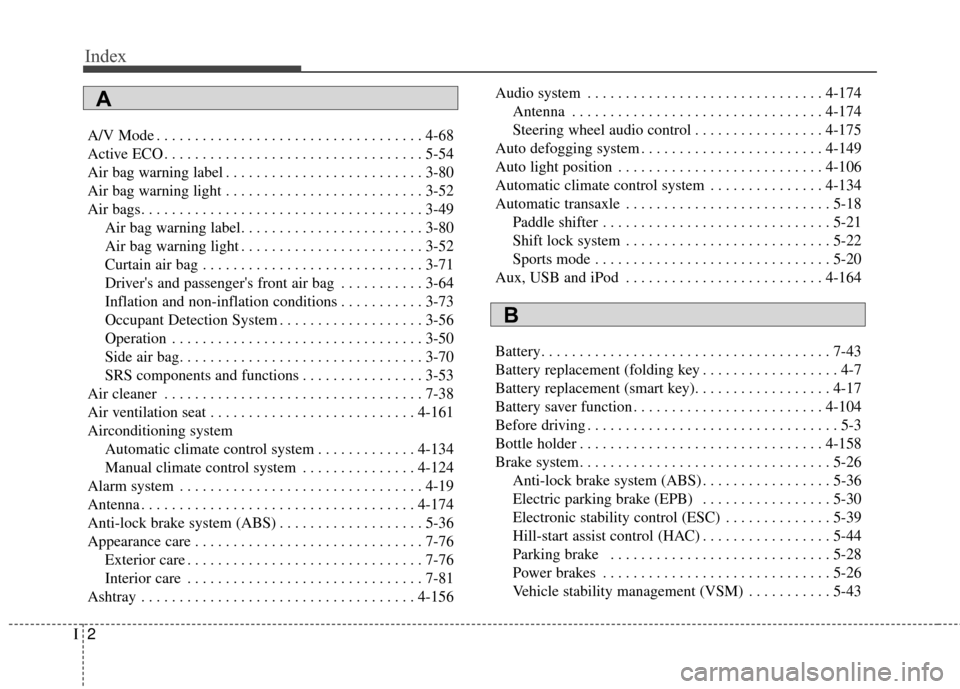
Index
2I
A/V Mode . . . . . . . . . . . . . . . . . . . . . . . . . . . . . . . . . . . 4-\
68
Active ECO . . . . . . . . . . . . . . . . . . . . . . . . . . . . . . . . . . 5-54\
Air bag warning label . . . . . . . . . . . . . . . . . . . . . . . . . . 3-80
Air bag warning light . . . . . . . . . . . . . . . . . . . . . . . . . . 3-52
Air bags. . . . . . . . . . . . . . . . . . . . . . . . . . . . . . . . . . . . \
. 3-49Air bag warning label. . . . . . . . . . . . . . . . . . . . . . . . 3-80
Air bag warning light . . . . . . . . . . . . . . . . . . . . . . . . 3-52
Curtain air bag . . . . . . . . . . . . . . . . . . . . . . . . . . . . . 3-71
Driver's and passenger's front air bag . . . . . . . . . . . 3-64
Inflation and non-inflation conditions . . . . . . . . . . . 3-73
Occupant Detection System . . . . . . . . . . . . . . . . . . . 3-56
Operation . . . . . . . . . . . . . . . . . . . . . . . . . . . . . . . . . 3-50
Side air bag. . . . . . . . . . . . . . . . . . . . . . . . . . . . . . . . 3-70
SRS components and functions . . . . . . . . . . . . . . . . 3-53
Air cleaner . . . . . . . . . . . . . . . . . . . . . . . . . . . . . . . . . . 7-38\
Air ventilation seat . . . . . . . . . . . . . . . . . . . . . . . . . . . 4-161
Airconditioning system Automatic climate control system . . . . . . . . . . . . . 4-134
Manual climate control system . . . . . . . . . . . . . . . 4-124
Alarm system . . . . . . . . . . . . . . . . . . . . . . . . . . . . . . . . 4-19
Antenna . . . . . . . . . . . . . . . . . . . . . . . . . . . . . . . . . . . . \
4-174
Anti-lock brake system (ABS) . . . . . . . . . . . . . . . . . . . 5-36
Appearance care . . . . . . . . . . . . . . . . . . . . . . . . . . . . . . 7-76 Exterior care . . . . . . . . . . . . . . . . . . . . . . . . . . . . . . . 7-76
Interior care . . . . . . . . . . . . . . . . . . . . . . . . . . . . . . . 7-81
Ashtray . . . . . . . . . . . . . . . . . . . . . . . . . . . . . . . . . . . . \
4-156 Audio system . . . . . . . . . . . . . . . . . . . . . . . . . . . . . . . 4-174
Antenna . . . . . . . . . . . . . . . . . . . . . . . . . . . . . . . . . 4-174
Steering wheel audio control . . . . . . . . . . . . . . . . . 4-175
Auto defogging system . . . . . . . . . . . . . . . . . . . . . . . . 4-149
Auto light position . . . . . . . . . . . . . . . . . . . . . . . . . . . 4-106
Automatic climate control system . . . . . . . . . . . . . . . 4-134
Automatic transaxle . . . . . . . . . . . . . . . . . . . . . . . . . . . 5-18 Paddle shifter . . . . . . . . . . . . . . . . . . . . . . . . . . . . . . 5-21
Shift lock system . . . . . . . . . . . . . . . . . . . . . . . . . . . 5-22
Sports mode . . . . . . . . . . . . . . . . . . . . . . . . . . . . . . . 5-20
Aux, USB and iPod . . . . . . . . . . . . . . . . . . . . . . . . . . 4-164
Battery. . . . . . . . . . . . . . . . . . . . . . . . . . . . . . . . . . . . \
. . 7-43
Battery replacement (folding key . . . . . . . . . . . . . . . . . . 4-7
Battery replacement (smart key). . . . . . . . . . . . . . . . . . 4-17
Battery saver function . . . . . . . . . . . . . . . . . . . . . . . . . 4-104
Before driving . . . . . . . . . . . . . . . . . . . . . . . . . . . . . . . . . 5-3
Bottle holder . . . . . . . . . . . . . . . . . . . . . . . . . . . . . . . . 4-158
Brake system. . . . . . . . . . . . . . . . . . . . . . . . . . . . . . . . . 5-26 Anti-lock brake system (ABS) . . . . . . . . . . . . . . . . . 5-36
Electric parking brake (EPB) . . . . . . . . . . . . . . . . . 5-30
Electronic stability control (ESC) . . . . . . . . . . . . . . 5-39
Hill-start assist control (HAC) . . . . . . . . . . . . . . . . . 5-44
Parking brake . . . . . . . . . . . . . . . . . . . . . . . . . . . . . 5-28
Power brakes . . . . . . . . . . . . . . . . . . . . . . . . . . . . . . 5-26
Vehicle stability management (VSM) . . . . . . . . . . . 5-43
A
B